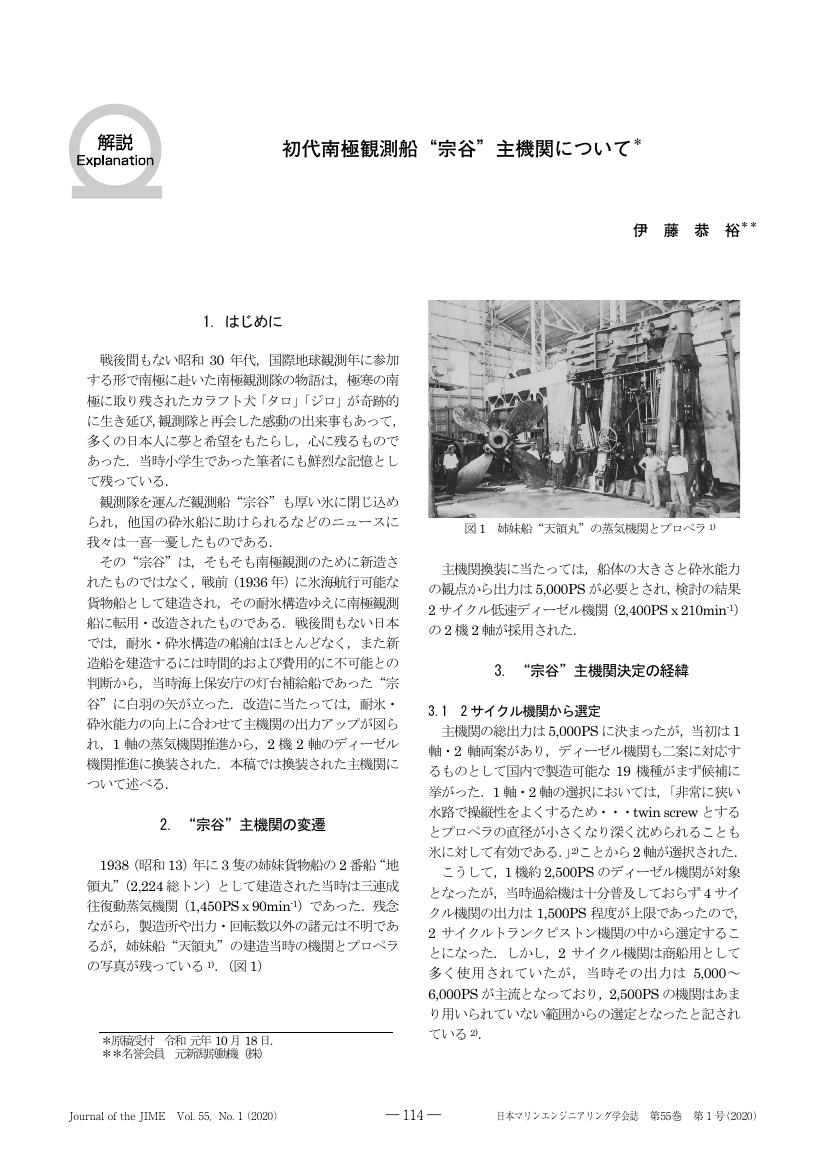8 0 0 0 OA 世界初のハイブリッド型CRPポッド推進高速フェリー
- 著者
- 上田 直樹 沼口 哉
- 出版者
- 公益社団法人 日本マリンエンジニアリング学会
- 雑誌
- マリンエンジニアリング (ISSN:13461427)
- 巻号頁・発行日
- vol.40, no.2, pp.209-214, 2005-03-01 (Released:2010-05-31)
- 参考文献数
- 6
- 被引用文献数
- 1
8 0 0 0 OA 高熱効率機関
- 著者
- 高石 龍夫
- 出版者
- 公益社団法人 日本マリンエンジニアリング学会
- 雑誌
- マリンエンジニアリング (ISSN:13461427)
- 巻号頁・発行日
- vol.50, no.2, pp.210-214, 2015-03-01 (Released:2016-11-10)
- 参考文献数
- 7
- 被引用文献数
- 3
8 0 0 0 OA 2012年におけるマリンエンジニアリング技術の進歩
7 0 0 0 OA 砕氷船用電気推進装置の特徴
- 著者
- 藤田 昌孝
- 出版者
- 公益社団法人 日本マリンエンジニアリング学会
- 雑誌
- マリンエンジニアリング (ISSN:13461427)
- 巻号頁・発行日
- vol.45, no.2, pp.233-235, 2010 (Released:2012-12-06)
- 参考文献数
- 5
- 被引用文献数
- 1 1
7 0 0 0 OA 阪神・淡路大震災を振り返って -神戸商船大学(現神戸大学海事科学部)の事例
- 著者
- 杉田 英昭
- 出版者
- 公益社団法人 日本マリンエンジニアリング学会
- 雑誌
- マリンエンジニアリング (ISSN:13461427)
- 巻号頁・発行日
- vol.47, no.2, pp.148-153, 2012-03-01 (Released:2013-10-30)
- 参考文献数
- 5
7 0 0 0 OA 初代南極観測船“宗谷”主機関について
- 著者
- 伊藤 恭裕
- 出版者
- 公益社団法人 日本マリンエンジニアリング学会
- 雑誌
- マリンエンジニアリング (ISSN:13461427)
- 巻号頁・発行日
- vol.55, no.1, pp.114-119, 2020-01-01 (Released:2020-01-29)
- 参考文献数
- 4
7 0 0 0 OA 砕氷艦のプロペラ
- 著者
- 水野 滋也 錦戸 真吾
- 出版者
- 公益社団法人 日本マリンエンジニアリング学会
- 雑誌
- マリンエンジニアリング (ISSN:13461427)
- 巻号頁・発行日
- vol.45, no.2, pp.221-226, 2010 (Released:2012-12-06)
7 0 0 0 OA ハイブリッドフェリー「さんふらわあ ふらの」竣工
- 著者
- 黒瀬 康弘
- 出版者
- 公益社団法人 日本マリンエンジニアリング学会
- 雑誌
- マリンエンジニアリング (ISSN:13461427)
- 巻号頁・発行日
- vol.52, no.5, pp.618-625, 2017-09-01 (Released:2018-03-07)
7 0 0 0 OA 流出油事故対応の現状について-準備,対応及び防除戦術の選択
- 著者
- 萩原 貴浩
- 出版者
- 公益社団法人 日本マリンエンジニアリング学会
- 雑誌
- マリンエンジニアリング (ISSN:13461427)
- 巻号頁・発行日
- vol.51, no.6, pp.805-811, 2016-11-01 (Released:2018-01-01)
- 参考文献数
- 3
6 0 0 0 OA 舞鶴館のご案内
- 著者
- ジャパン マリンユナイテッド株式会社 舞鶴事業所
- 出版者
- 公益社団法人 日本マリンエンジニアリング学会
- 雑誌
- マリンエンジニアリング (ISSN:13461427)
- 巻号頁・発行日
- vol.53, no.1, pp.114-123, 2018-01-01 (Released:2018-03-14)
6 0 0 0 OA 小笠原就航TSLの概要と推進システムについて
- 著者
- 小林 明生 山賀 秀夫
- 出版者
- 公益社団法人 日本マリンエンジニアリング学会
- 雑誌
- マリンエンジニアリング (ISSN:13461427)
- 巻号頁・発行日
- vol.39, no.12, pp.811-816, 2004-12-01 (Released:2010-05-31)
- 参考文献数
- 4
6 0 0 0 OA 海底資源探査技術の事例 - 3次元海底資源探査船『RAMFORM TITAN』の紹介
- 著者
- 森 英男
- 出版者
- 公益社団法人 日本マリンエンジニアリング学会
- 雑誌
- マリンエンジニアリング (ISSN:13461427)
- 巻号頁・発行日
- vol.50, no.5, pp.659-663, 2015-09-01 (Released:2016-12-03)
- 参考文献数
- 1
6 0 0 0 OA 東日本大震災における航海訓練所練習船の救援活動
- 著者
- 阪根 靖彦
- 出版者
- 公益社団法人 日本マリンエンジニアリング学会
- 雑誌
- マリンエンジニアリング (ISSN:13461427)
- 巻号頁・発行日
- vol.47, no.2, pp.184-189, 2012-03-01 (Released:2013-10-30)
6 0 0 0 OA クルージングリゾート “らべんだあ”
- 著者
- 清水 寿男
- 出版者
- 公益社団法人 日本マリンエンジニアリング学会
- 雑誌
- マリンエンジニアリング (ISSN:13461427)
- 巻号頁・発行日
- vol.52, no.5, pp.640-645, 2017-09-01 (Released:2018-03-07)
6 0 0 0 OA 航空機排出ガスに関する規制と環境影響評価
- 著者
- 早乙女 拓海
- 出版者
- 公益社団法人 日本マリンエンジニアリング学会
- 雑誌
- マリンエンジニアリング (ISSN:13461427)
- 巻号頁・発行日
- vol.49, no.6, pp.788-793, 2014-11-01 (Released:2015-12-16)
- 参考文献数
- 17
- 被引用文献数
- 1
6 0 0 0 海水潤滑ゴム軸受における軸スリーブ損傷の研究 : 第1報
- 著者
- 吉川 文隆 矢野 昭彦 内田 幸宏 藤田 健二 川添 強 佐田 裕之
- 出版者
- The Japan Institute of Marine Engineering
- 雑誌
- Marine engineering : journal of the Japan Institution of Marine Engineering = マリンエンジニアリング : 日本マリンエンジニアリング学会誌 (ISSN:13461427)
- 巻号頁・発行日
- vol.43, no.1, pp.123-129, 2008-03-01
- 参考文献数
- 7
- 被引用文献数
- 1
Propeller shaft diameter of ferries becomes larger in conjunction with requirements of higher vessel's speed and CPPs (controllable pitch propellers) . Thus, it may lead into a tendency to reduce the life duration of stem tube bearing under seawater lubrication. Wear of the propeller shaft sleeve, i.e. bronze alloy, is typically greater than that of the rubber bearings, with triangularly shaped craters appearing on the sleeve surface.<BR>In this paper, we describe the investigation of used sleeve sample taken from an actual vessel, as well as the wear characteristics of bronze alloys conducted under the corrosive wear condition which is equivalent to actual ferry service. The results indicated that corrosive wear was the main cause of sleeve wear. Comparing between the amount of wear in seawater and the one in distilled water, the influence of corrosion on sleeve wear was found to be substantial. Additionally, the craters are considered to be formed by the action of erosion corrosion
5 0 0 0 OA LNG運搬船の事故による環境影響
- 著者
- 柳 裕一朗 松井 裕 太田 進 伊藤 博子 石村 惠以子
- 出版者
- 公益社団法人 日本マリンエンジニアリング学会
- 雑誌
- マリンエンジニアリング (ISSN:13461427)
- 巻号頁・発行日
- vol.46, no.6, pp.914-919, 2011 (Released:2013-10-23)
- 参考文献数
- 5
Natural gas produces less carbon dioxide, nitrogen oxides and sulfur oxides per unit heat released than other fossil fuels such as oil and coal. In line with efforts to preserve global environment and to promote sustainable development of world economy, the demand for natural gas has steadily increased. This study was conducted to analyze the risk of GHG (greenhouse gas) release caused by accidents involving natural gas carriers. LNG, which stands for Liquefied Natural Gas, is composed mainly of CH4, so the composition of LNG was assumed to be 100% CH4. Also, the other components of natural gas are not recognized as GHG. To estimate the maximum environmental impact, “Q-Max” which is currently the largest LNG carrier was used as the reference ship. For comparison, CO2 emissions from the propulsion engine were calculated. The environmental impact due to accidents was insignificant compared with the impact of CO2 emissions from the propulsion engine.
5 0 0 0 OA 戦前・戦時中に活躍した複動ディーゼル機関について
- 著者
- 田山 経二郎
- 出版者
- 公益社団法人 日本マリンエンジニアリング学会
- 雑誌
- マリンエンジニアリング (ISSN:13461427)
- 巻号頁・発行日
- vol.49, no.3, pp.387-392, 2014-05-11 (Released:2015-11-17)
- 参考文献数
- 5
- 被引用文献数
- 1
5 0 0 0 OA フェリーさんふらわあ 新造船 - 新造船のコンセプトと目指すもの
- 著者
- 一村 嗣郎
- 出版者
- 公益社団法人 日本マリンエンジニアリング学会
- 雑誌
- マリンエンジニアリング (ISSN:13461427)
- 巻号頁・発行日
- vol.52, no.5, pp.646-650, 2017-09-01 (Released:2018-03-07)
- 参考文献数
- 2
5 0 0 0 OA タービン船の歴史
- 著者
- 見上 博
- 出版者
- 公益社団法人 日本マリンエンジニアリング学会
- 雑誌
- マリンエンジニアリング (ISSN:13461427)
- 巻号頁・発行日
- vol.44, no.4, pp.557-562, 2009 (Released:2012-07-25)
- 参考文献数
- 10

















